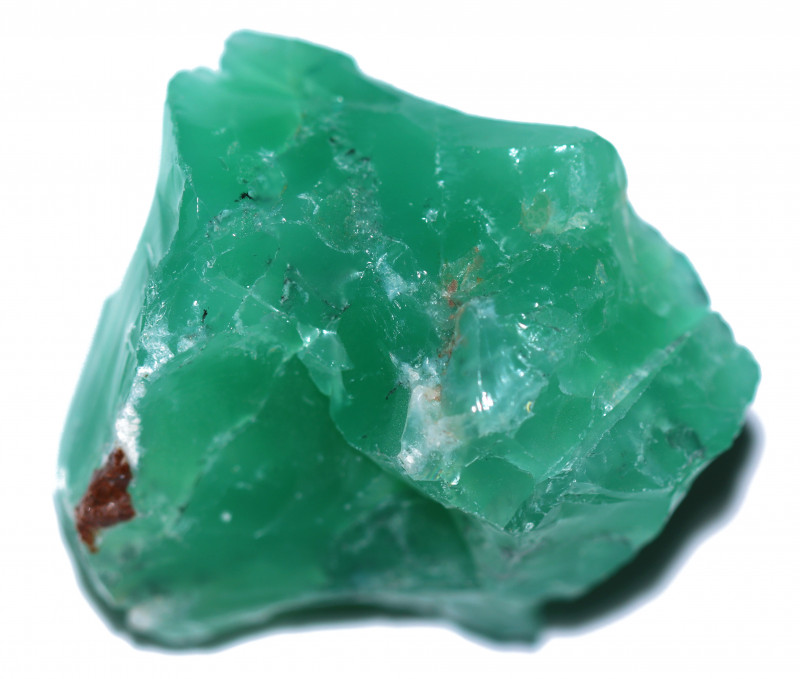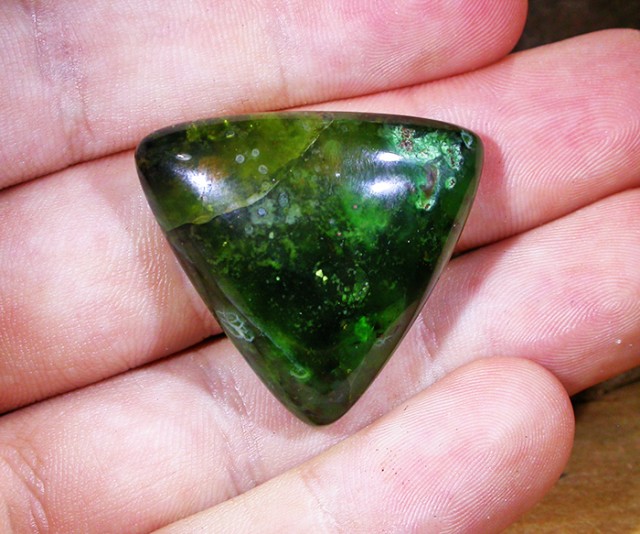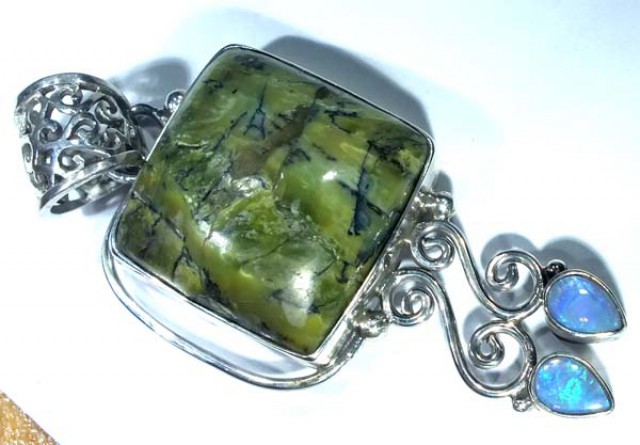
Green Opals: History, Symbolism, Meanings & More!
 Green opals are stunning common opal variants that are renowned for their vibrant green body color. Though this stone is less sought after than its more iridescent counterparts, green opals still have an earthy and natural allure that stands out against other gemstones.
Green opals are stunning common opal variants that are renowned for their vibrant green body color. Though this stone is less sought after than its more iridescent counterparts, green opals still have an earthy and natural allure that stands out against other gemstones.
You can find green opal raw, tumbled, and even faceted, and they are often sold for spiritual healing and cleansing practices. There’s a lot to learn about this emerald-hued gem!
In this article, we’ll review the composition and geological background of green opal, as well as its physical properties, history, meaning, and spiritual benefits.
What Is A Green Opal?
On a chemical level, what is green opal? Well, like other opals, green opals are a hydrated amorphous form of silica (hence their chemical formula, SiO2·nH2O). They have more or less the same chemical composition as minerals like quartz, but with a more disorganized internal structure. Additionally, green opals often include nickel in their formation (especially in the case of prase opals) which creates their characteristic green hue.
Green opal can come in a variety of shades, from deep and saturated emerald greens to yellowish and mature chartreuses. Many green opals come in a muted jade color, to the point where cut and polished versions of green opal could be easily mistaken for jade when set in jewelry.
On the Mohs mineral hardness scale, green opal ranges between 5.5-6. While this is not much lower than the hardness for other semi-precious stones like moonstone, it still means that any green opal rings, necklaces, earrings, or other forms of polished jewelry can be prone to scratching.
When this happens, it can cloud your green opal’s surface and cause any visual effects, like a cat’s eye effect or an adularescent gleam, to become indistinct and hard to see.
Getting your opal jewelry professionally repolished and recut can help with this, especially if you have an engagement ring or another opal jewelry item that you wear on a regular basis.

Green Opal Origins
So where does green opal come from? Green opals can come from any common opal vein. However, certain locations specialize in mining green opals:
Tanzania: This African nation is well-known for its prase opal mines. Prase opals are a type of green opal noted for their translucency and high quality, and vibrant, jade-like color. You can’t buy this variety of green opal tumbled, as they are most often cut into faceted stones or cabochons for jewelry.
Madagascar: Madagascar green opals are beautiful stones that come in earthy lime-green shades. This variety has an organic appearance, and they are popular spiritual crystals. Untumbled, natural green opals of this variety are particularly prized.
Green Opal Gemstone Properties
Green opal forms when silica spheres, sourced from silicate rocks eroded by running water, pool together with water to form a silica-rich mixture. This mixture then drips through cracks or fissures in the earth to form a concentration of silica spheres that arrange in complex layers to form opals.
Physical green opal properties, like the arrangement of these spheres into structured layers and the shape of the spheres themselves, allow for light to diffract through the opals.
Almost every opal labeled as “green opal” is common rather than precious.
In terms of opal classification, “common” refers to opal varieties that aren’t transparent and don’t include the iridescent play-of-color that opals are known for. Instead, they may display a dull, whitish luster under their surface called adularescence.
While some vendors may sell white precious opals with green play-of-color, these are not necessarily green opals, as “green” refers to the stone’s body color or body tone.
Inclusions, or foreign materials or substances that get trapped inside an opal, can form in green opals to give them a particularly gorgeous effect. Opal inclusions are relatively rare and can be made from a wide variety of minerals and organic substances, from iron “dendrites” — little moss-like mineral formations — to sticks and even ancient bugs and opalized animal fossils.
While green opals may not display inclusions as prominently as more transparent stones, it can still be nothing short of stunning to see a verdant opal with mossy iron inclusions trapped within.

How to Identify Green Opal
Is green opal natural? Or are there artificial imitations that saturate the market?
Well, green opal should be all-natural, but unfortunately, there are plenty of imitation opals and even mislabeled minerals on the market being sold as green opals. Jade and cut glass may be sold in place of prase opals, and it’s not unheard of for serpentine or prasiolite to be sold as green opal, too.
One of the more well-known (and more dangerous) instances of dishonest stone selling is with the sale of “green swiss opal.” This is never opal; instead, it’s often a fibrous form of the mineral serpentine called chrysolite. Chrysolite has been frequently used in construction as an asbestos, and it poses a real threat to your long-term health if its dust is inhaled.
This may be another reason for consumers to learn how to identify green opal; while glass substitutes are a bit lackluster and disappointing, some substitutes can potentially kill you!
Here are some ways to recognize green opal:
Look for a slight milky luster right under the surface. While this isn’t always there, it’s characteristic of common opal, and it’s not found in similar-looking stones like quartz.
Avoid banded or otherwise strangely patterned stones. Green opals, if they aren’t a solid green, will have small organic-looking speckles or webbing. They will not have horizontal stripes like those seen in chrysolite.
Conduct a scratch test. Opals are softer than many other stones, and scratching them could indicate that the stone at hand is uniquely soft.
So, we’ve looked at green opal features and characteristics, but how rare is the gemstone?
Is Green Opal Rare?
Green opal is not particularly rare, as it’s a common opal rather than precious opal. Over 95% of all opals mined are common, leaving only a small margin for precious opals to proliferate. Furthermore, green is not an especially rare common opal color, making it a frequently encountered opal variety.
Well, if it’s not rare, is green opal valuable?
Not particularly. While green opal prices obviously vary based on the quality of the opal, even when it comes to common opals, they are not particularly valuable. Common opals aren’t semi-precious stones; they’re not considered especially valuable by consumer markets, likely because they lack the play-of-color seen in precious opals.
Green Opal History
While the name “green opal” itself has a pretty intuitive backstory — it’s, y’know, an opal that’s green — the word “opal” itself has interesting origins.
Some scholars argue that the word comes from the word upala in Sanskrit, meaning “precious stone.” Others argue that it could derive from the Greek word for the action of “seeing a change of color,” opallios.
Regardless of the history of its name, however, there is little known about the history of mining for green opals in particular. One source posits that the first prase opal in Tanzania was found in 1975, and mining operations have been established there ever since.
However, in terms of common green opal in general, it’s pretty safe to assume that humans have known of them for as long as we have known of opals — so, about 6,000 years, give or take. After all, the vast, vast majority of opals are common, and a significant portion of common opals are green.
Unfortunately, the lack of demand for common opal has prevented most kinds of green opal varieties from having a particularly storied past. It seems only in recent years has a market opened up for the non-precious common opal to be featured in jewelry or used as spiritual healing tools.
![30.50 CTS PRASE OPAL PARCEL FROM TANZANIA [MS8218]](https://df2sm3urulav.cloudfront.net/tenants/oa/uploads/images/970000-974999/970189/5fbda9145c853.jpg)
Green Opal Meaning & Symbolism
Historically, green gemstones have been associated with a number of meanings, chief among them being the power to heal the eyes and relieve eye strain. However, what do opals mean spiritually? What does green opal symbolize?
Green opal meanings are often representative of the heart and one’s emotions, according to many contemporary spiritual practices. Carrying green opal or having a green opal set in your jewelry may bring good fortune to your relationships and help you to feel grounded and in touch with your feelings.
Additionally, green gemstones are thought to be associated with nature and renewal, making them a great option for individuals who are looking to become more grounded in the natural world.
And of course, we can’t leave out one of the oldest symbolisms associated with the color green: good luck! Contrary to the myth that opals are bad luck, green opals can boast good fortune and prosperity to wearers!
Opals are conduits for healing and growth, so how can their properties benefit you?

Green Opal Healing Properties
One of the many green opal crystal meanings is emotion. Green opal is intimately tied to affairs of the heart and the heart chakra, so it makes complete sense that its healing properties would revolve around easing emotional wounds and strains.
The stone is purported to restore your emotional strength in periods when you feel devoid of motivation, but it can also calm turbulent emotions and prevent them from ruling your life. Some spiritualists claim they use this stone in the wake of difficult emotional events, like breakups, fights, and disruptions to long-term plans or goals.
On a physical level, some claim that green opal can help to reduce fevers, ease infections, and improve cognition.
If you’re looking to take advantage of green opal metaphysical properties, consider carrying a piece with you in a purse, pocket, or satchel. According to some spiritualists, green opal benefits can include easing burdensome feelings about your relationships and helping you to regulate your emotions.
Green Opal Chakra
How can green opal heal your chakras, and what chakra is green opal associated with? Green opal is best used to unblock the heart chakra. The heart chakra, located in the center of your chest, is connected to one’s ability to form relationships, love oneself and others, and experience joy in daily life.
The chakra is rooted in feeling, and a blocked heart chakra can really hinder your compassion, love, and patience. Some signs of a blocked heart chakra include:
Depression
Social anxiety
Isolation
Unempathetic responses
Healing with green opal gemstones can unblock the heart chakra, opening your heart to compassion and unconditional love with much more clarity and enthusiasm. You’ll find a new pep in your step, one filled with joy and exuberance that propels you to engage deeper in your relationships.
![74.65 CTS TUMBLED PERU OPAL PARCEL [VS7751]](https://df2sm3urulav.cloudfront.net/tenants/oa/uploads/images/655000-659999/658504/5953275ee1f91.jpg)
Bring Green Opals into Your Home Today!
We’ve covered a lot of ground with green opals in this guide. If you’ve got a hunch that the grass is, in fact, greener on the other side, use opal gems to take you to new pastures!
Though green opals may not be considered technically as precious as their iridescent counterparts like white opal, black opal, and crystal opals, they offer a wide variety of helpful benefits to your emotional and spiritual health.
Beyond that, however, green opals hold an uncommon beauty not found in many other opals. While flashes of light are obviously pretty, common green opals are also gorgeous in such a distinct way; they are vibrant green stones that almost look like small, mossy river stones. They can be partially translucent and showcase a lustrous effect, making them strong contenders against the beauty of precious stones.
If you’re looking to find reprieve from some recent emotional difficulties, or if you’re on the hunt for a unique stone to wear in a ring, necklace, or pair of earrings, consider purchasing the allure of a beautiful green opal gemstone!
Search the Opal Encyclopedia
Related Auctions
Related Articles
Crystal opal is a type of opal renowned for its translucence and vibrant iridescence. In this guide, we'll walk you through everything you need to know about this splendid stone.
17th Jul 2018
Ethiopian opals are a relatively new group of hydrophane opals with impressive play-of-color in a variety of patterns. Learn the history and uses of Ethiopian opals!
23rd May 2018
Green Opal and Dendritic Opal are all found in Tanzania and posses stunning rolling-fire flashes. Green Opal is a very unique and rare type of Opal
8th May 2018
Latest Articles
An opal’s price comes down to a variety of factors, all of which we’ve broken down in this guide to opal grading and prices. Learn all about opal grading and the prices of each type of opal!
19th Jul 2023
Come on a journey and learn about the healing power of opals from our guest writer Vivien Schapera from Crystal Healing Techniques!
20th May 2023
The Flame (or Fire) Queen opal is the world’s most expensive opal, sold for the modern equivalent of $3 million dollars. Learn all about its history and qualities!
18th Feb 2023
Article Categories
All there is to know about Opals including Black Opals, Ethiopian Opals & Boulder Opal
15 Articles
Check out our fascinating information and articles on all things amazing in the Opal world
43 Articles
Opal Auctions sellers who are approved as opal Verified Sellers
4 Articles








